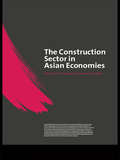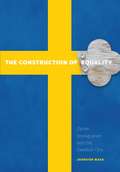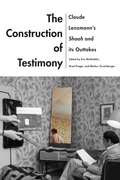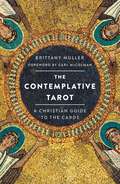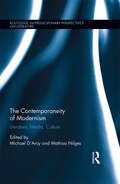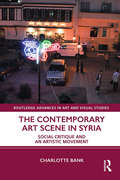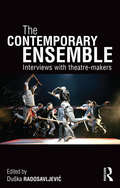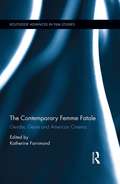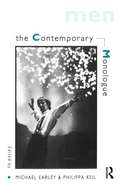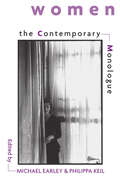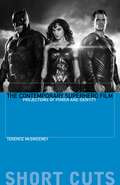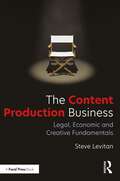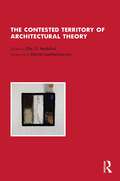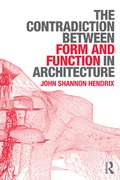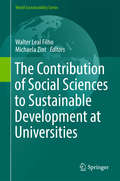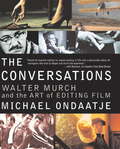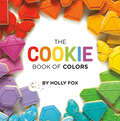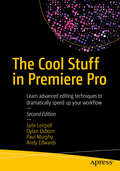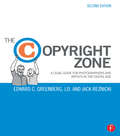- Table View
- List View
The Construction Sector in the Asian Economies
by John Raftery Michael Anson Y.H. ChiangThis collection of essential data on eleven Asian economies outlines new trends and highlighting increasing differences between developed and developing countries. The book features a detailed analysis of the state of the construction industry and its economic effects in Australia, China Mainland, China Hong Kong, India, Indonesia, Japan, South Korea, Philippines, Singapore, Sri Lanka and Vietnam.
The Construction of Drawings and Movies: Models for Architectural Design and Analysis
by Thomas ForgetThe architectural imagery that you create is most effective when it examines your project in an abstract manner. Most students and practitioners understand linear perspective and cinema to be examples of architectural presentation tools. This book asks you to consider drawings and movies to be analytical tools that give you the capacity to engage all phases of the design process, from parti to presentation. The ways in which spaces relate to each other and how materials connect to each other in your projects are as important as your building’s appearance. As digital tools increasingly allow you to simulate the experience of built and unbuilt environments, it is essential that you scrutinize the nature of architectural imagery and resist the lure of virtual reality. Though pure simulation may be appropriate for your clients, your design process requires abstraction and analysis. Author Thomas Forget demonstrates how to construct analytical drawings and movies that challenge the alleged realism of linear perspective and cinema. These demonstrations expose you to underlying principles that will allow you to understand the broader implications of these methods. In addition, historical surveys of drawings and movies provide you with insight into how architects and architectural historians have understood the role of linear perspective and cinema in their fields. Finally, examples of drawing and moviemaking strategies illustrate how you can apply the lessons of the book to precedent analyses and design projects.
The Construction of Equality: Syriac Immigration and the Swedish City
by Jennifer MackAn industrial city on the outskirts of Stockholm, Södertälje is the global capital of the Syriac Orthodox Christian diaspora, an ethnic and religious minority group fleeing persecution and discrimination in the Middle East. Since the 1960s, this Syriac community has transformed the standardized welfare state spaces of the city&’s neighborhoods into its own &“Mesopotälje,&” defined by houses with Mediterranean and other international influences, a major soccer stadium, and massive churches and social clubs. Such projects have challenged principles of Swedish utopian architecture and planning that explicitly emphasized the erasure of difference. In The Construction of Equality, Jennifer Mack shows how Syriac-instigated architectural projects and spatial practices have altered the city&’s built environment &“from below,&” offering a fresh perspective on segregation in the European modernist suburbs.Combining architectural, urban, and ethnographic tools through archival research, site work, participant observation (among residents, designers, and planners), and interviews, Mack provides a unique take on urban development, social change, and the immigrant experience in Europe over a fifty-year period. Her book shows how the transformation of space at the urban scale—the creation and evolution of commercial and social districts, for example—operates through the slow accumulation of architectural projects. As Mack demonstrates, these developments are not merely the result of the grassroots social practices usually attributed to immigrants but instead are officially approved through dialogues between residents and design professionals: accredited architects, urban planners, and civic bureaucrats. Mack attends to the tensions between the &“enclavization&” practices of a historically persecuted minority group, the integration policies of the Swedish welfare state and its planners, and European nativism.
The Construction of Testimony: Claude Lanzmann’s Shoah and Its Outtakes (Contemporary Approaches to Film and Media Series)
by Brad Prager Noah Shenker Tobias Ebbrecht-Hartmann Debarati Sanyal Sue Vice Dorota Glowacka Erin McGlothlin Markus Zisselsberger Jennifer Cazenave Regina Longo Leslie Swift Gary Weissman Leah Wolfson Michel VranaIn The Construction of Testimony: Claude Lanzmann’s Shoah and Its Outtakes, editors Erin McGlothlin, Brad Prager, and Markus Zisselsberger gather contributions on how Shoah (1985) fundamentally changed the nature and use of filmed testimony and laid the groundwork for how historians and documentarians regard and understand the history of the Holocaust. Critics have taken long note of Shoah’s innovative style and its place in the history of documentary film and in cultural memory, but few scholars have touched on its extensive outtakes and the reams of documentation archived at the United States Holocaust Memorial Museum and at Yad Vashem, or the release of five feature-length documentaries based on the material in those outtakes. The Construction of Testimony, which contains thirteen essays by some of the most notable scholars in Holocaust film studies, reexamines Lanzmann’s body of work, his film, and the impact of Shoah through this trove—over 220 hours—of previously unavailable and unexplored footage. Responding to the need for a sustained examination of Lanzmann’s impact on historical and filmic approaches to testimony, this volume inaugurates a new era of scholarship, one that takes a critical position vis-à-vis the filmmaker’s posturing, stylization, and editorial sleight-of-hand. The volume’s contributors engage with a range of dimensions central to Lanzmann’s filmography and the outtakes, including the dynamics of gender in his work, his representation of Nazi perpetrators, and complex issues of language and translation. In light of Lanzmann’s invention of a radically new form of witnessing and remembrance, Shoah laid the framework for the ways in which subsequent filmmakers have represented the Holocaust cinematically; at the same time, the outtakes complicate this framework by revealing new details about the filmmaker’s complex editorial choices. Scholars and students of film studies and Holocaust studies will value this close analysis.
The Consummate Canadian: A Biography of Samuel Weir Q.C.
by Mary Willan MasonSamuel Edward Weir Q.C. (1898-1981), a man both loved and reviled with scorn, was born in London, Ontario. Descended from pioneer stock, with roots in both Ireland and Germany, Samuel Weir possessed incisive wit, exceptional intelligence and a passionate zest for any subject that caught his eye. Over a period of sixty years he built an extraordinary collection of approximately one thousand works of outstanding art and sculpture. This extensively researched biography of a talented yet quixotic lawyer who contributed much to Canada’s heritage begins in the early 19th century and covers well over a hundred years of our nation’s growth, until his death at his home, River Brink, in Queenston, Ontario. Today, River Brink is the gallery in which The Weir Collection is exhibited and housed.
The Contemplative Tarot: A Christian Guide to the Cards
by Brittany Muller“This insightful book will help you to see both the cards—and Christian spirituality—in surprising new ways."— Carl McColman, author of The Big Book of Christian Mysticism and Eternal HeartIn the chaos of daily life, many Christians long for the time and mental clarity to reflect on scripture, to worship, and to pray. The Tarot can become an unexpected tool in this journey, inviting us to pause, contemplate, and find insight and wisdom in our walk. In The Contemplative Tarot, author Brittany Muller draws deeply on Christian tradition and theology to create a tarot practice built on spiritual reflection, prayer, and worship.The Tarot has held countless meanings to countless readers over the course of its existence, but The Contemplative Tarot offers a uniquely Christian interpretation of the cards, including Bible verses and meditations on each of their spiritual meanings. Brittany provides practical guidance on how to use the cards in a Christian context, whether as prompts for personal prayer, daily reminders of spiritual truths, or as part of a more structured practice such as the Ignatian examen.The Contemplative Tarot offers a thoughtful, introspective new interpretation of the Tarot and an invitation to create powerful moments of reflection and worship in your daily life.
The Contemporaneity of Modernism: Literature, Media, Culture (Routledge Interdisciplinary Perspectives on Literature)
by Mathias Nilges Michael D'ArcyAt a juncture in which art and culture are saturated with the forces of commodification, this book argues that problems, forms, and positions that defined modernism are crucially relevant to the condition of contemporary art and culture. The volume is attuned to the central concerns of recent scholarship on modernism and contemporary culture: the problems of aesthetic autonomy and the specific role of art in preserving a critical standpoint for cultural production; the relationship between politics and the category of the aesthetic; the problems of temporality and contemporaneity; literary transnationalism; and the questions of medium and medium specificity. Ranging across art forms, mediums, disciplines, and geographical locations, essays address the foundational questions that fuse modernism and the contemporary moment: What is art? What is the relation between art and the economy? How do art and technology interpenetrate and transform each other? What is modernism’s logic of time and contemporaneity, and how might it speak to the problem of thinking genuine novelty, or the possibility of an alternative to the current stage of neo-liberal capitalism? What is modernism, and what is its history? The book is thus committed to revising our understanding of what modernism was in its earlier instantiations, and in accounting for the current moment, addressing the problems raised by modernism's afterlives and reverberations in the 20th and 21st centuries. The volume includes essays that consider literature, sociology, philosophy, visual art, music, architecture, digital culture, television, and other artistic media. It synthesizes the most recent thinking on modernism and contemporary culture and presents a compelling case for what happens to literature, art, and culture in the wake of the exhaustion of postmodernism. This book will be of interest to those studying literature, visual art, media studies, architecture, literary theory, modernism, and twentieth-century and contemporary culture more generally.
The Contemporary Art Scene in Syria: Social Critique and an Artistic Movement (Routledge Advances in Art and Visual Studies)
by Charlotte BankThis book focuses on the expanding contemporary art scene in Syria, particularly Damascus, during the first decade of the twenty-first century. The decade was characterized by a high degree of experimentation as young artists began to work with artistic media that were new in Syria, such as video, installation and performance art. They were rethinking the role of artists in society and looking for ways to reach audiences in a more direct manner and address socio-cultural and socio-political issues. The Contemporary Art Scene in Syria will be of interest to scholars of global and Middle Eastern art studies, and also to scholars interested in the recent social and cultural history of Syria and the wider Middle East.
The Contemporary Ensemble: Interviews with Theatre-Makers
by Duška Radosavljević‘Dr. Radosavljević has an excellent and extensive grasp of her subject, and deep understanding of not only the history of these groups, but how they function, and how each contributes to the field of ensemble theatre.’ – David Crespy, University of Missouri, USA Questions of ensemble – what it is, how it works – are both inherent to a variety of Western theatre traditions, and re-emerging and evolving in striking new ways in the twenty-first century. The Contemporary Ensemble draws together an unprecedented range of original interviews with world-renowned theatre-makers in order to directly address both the former and latter concerns. Reflecting on ‘the ensemble way of working’ within this major new resource are figures including: Michael Boyd, Hermann Wündrich, Yuri Butusov, Max Stafford-Clark, Elizabeth LeCompte, Lyn Gardner, Adriano Shaplin, Phelim McDermott; and Emma Rice; representing companies including: The RSC; The Berliner Ensemble; The Satirikon Theatre; Out of Joint; The Wooster Group; Kneehigh Theatre; Song of the Goat; The Riot Group; The Neo-Futurists; Shadow Casters; and Ontroerend Goed. All 22 interviews were conducted especially for the collection, and draw upon the author’s rich background working as scholar, educator and dramaturg with a variety of ensembles. The resulting compendium radically re-situates the ensemble in the context of globalisation, higher education and simplistic understandings of ‘text-based’ and ‘devised’ theatre practice, and traces a compelling new line through the contemporary theatre landscape.
The Contemporary Femme Fatale: Gender, Genre and American Cinema (Routledge Advances in Film Studies)
by Katherine FarrimondThe femme fatale occupies a precarious yet highly visible space in contemporary cinema. From sci-fi alien women to teenage bad girls, filmmakers continue to draw on the notion of the sexy deadly woman in ways which traverse boundaries of genre and narrative. This book charts the articulations of the femme fatale in American cinema of the past twenty years, and contends that, despite her problematic relationship with feminism, she offers a vital means for reading the connections between mainstream cinema and representations of female agency. The films discussed raise questions about the limits and potential of positioning women who meet highly normative standards of beauty as powerful icons of female agency. They point towards the constant shifting between patriarchal appropriation and feminist recuperation that inevitably accompanies such representations within mainstream media contexts.
The Contemporary Monologue: Men (Monologue And Scene Bks.)
by Michael Earley Philippa KeilFirst Published in 1995. Routledge is an imprint of Taylor & Francis, an informa company.
The Contemporary Monologue: Women
by Michael EarleyFirst published in 1995. Routledge is an imprint of Taylor & Francis, an informa company.
The Contemporary Superhero Film: Projections of Power and Identity (Short Cuts)
by Terence McSweeneyAudiences around the globe continue to flock to see the latest releases from Marvel and DC studios, making it clear that superhero films resonate with the largest global audience that Hollywood has ever reached. Yet despite dominating theater screens like never before, the superhero genre remains critically marginalized—ignored at best and more often actively maligned.Terence McSweeney examines this global phenomenon, providing a concise and up-to-date overview of the superhero genre. He lays out its narrative codes and conventions, exploring why it appeals to diverse audiences and what it has to say about the world in the first two decades of the twenty-first century. Unpacking the social, ideological, and cultural content of superhero films, he argues that the genre should be considered a barometer of contemporary social anxieties and a reflection of cultural values. McSweeney scrutinizes representations of gender, race, and sexuality as well as how the genre’s conventions relate to and comment on contemporary political debates. Beyond American contributions to the genre, the book also features extensive analysis of superhero films from all over the world, contrasting them with the dominant U.S. model.The book’s presentation of a range of case studies and critical debates is accessible and engaging for students, scholars, and enthusiasts at all levels.
The Content Production Business: Legal, Economic and Creative Basics for Producers
by Steve LevitanThis book goes beyond the technical steps in the process of making film, TV, and media material, examining what it means to be an ongoing supplier of content to the marketplace and how to become one. Steve Levitan brings insights and experience from his lifelong career producing in the content industry, where he has also acted as a professional advisor to content makers, distributors and providers, whilst setting up his own production company. Producing as a Business offers strategic, tactical, financial, legal and marketing insights for the successful establishment of content creation enterprises. Readers will gain insight into how to avoid starting from square one with each project, while also learning how to maintain a meaningful level of ownership and build a revenue stream that can sustain a core operation, helping establish them as a “player” in the industry. This text is aimed at the international production industry, with real examples referred to throughout. Film, television, and media production students who are looking to understandthe business of producing, as well as first-time producers who are already familiar with the basics of the production process, will benefit from an examination of the building blocks that form lasting production companies.
The Content of Our Caricature: African American Comic Art and Political Belonging (Postmillennial Pop #25)
by Rebecca WanzoWinner, 2021 Katherine Singer Kovács Book Award, given by the Society for Cinema and Media StudiesWinner, 2021 Will Eisner Comic Industry Awards for Best Academic/Scholarly WorkHonorable Mention, 2021 Harry Shaw and Katrina Hazzard-Donald Award for Outstanding Work in African-American Popular Culture Studies, given by the Popular Culture AssociationWinner, 2020 Charles Hatfield Book Prize, given by the Comic Studies SocietyTraces the history of racial caricature and the ways that Black cartoonists have turned this visual grammar on its headRevealing the long aesthetic tradition of African American cartoonists who have made use of racist caricature as a black diasporic art practice, Rebecca Wanzo demonstrates how these artists have resisted histories of visual imperialism and their legacies. Moving beyond binaries of positive and negative representation, many black cartoonists have used caricatures to criticize constructions of ideal citizenship in the United States, as well as the alienation of African Americans from such imaginaries. The Content of Our Caricature urges readers to recognize how the wide circulation of comic and cartoon art contributes to a common language of both national belonging and exclusion in the United States.Historically, white artists have rendered white caricatures as virtuous representations of American identity, while their caricatures of African Americans are excluded from these kinds of idealized discourses. Employing a rich illustration program of color and black-and-white reproductions, Wanzo explores the works of artists such as Sam Milai, Larry Fuller, Richard “Grass” Green, Brumsic Brandon Jr., Jennifer Cruté, Aaron McGruder, Kyle Baker, Ollie Harrington, and George Herriman, all of whom negotiate and navigate this troublesome history of caricature. The Content of Our Caricature arrives at a gateway to understanding how a visual grammar of citizenship, and hence American identity itself, has been constructed.
The Contested Territory of Architectural Theory
by David Leatherbarrow Elie G. HaddadThis book brings together a diverse group of theoreticians to explore architectural theory as a discipline, assessing its condition and relevance to contemporary practice. Offering critical assessment in the face of major social and environmental issues of today, 17 original contributions address the relevance of architectural theory in the contemporary world from various perspectives, including but not limited to: politics, gender, representation, race, environmental crisis, and history. The chapters are grouped into two distinct sections: the first section explores various historical perspectives on architectural theory, mapping theory’s historiographical turn and its emergence and decline from the 1960s to the present; the second offers alternative visions and new directions for architectural theory, incorporating feminist and human rights perspectives, and addressing contemporary issues such as Artificial Intelligence and the Age of Acceleration. This edited collection features contributions from renowned scholars as well as emergent voices, with a Foreword by David Leatherbarrow. This book will be of great interest to graduate and upper-level students of architecture, as well as academics and practicing architects.
The Contradiction Between Form and Function in Architecture
by John Shannon HendrixContinuing the themes that have been addressed in The Humanities in Architectural Design and The Cultural Role of Architecture, this book illustrates the important role that a contradiction between form and function plays in compositional strategies in architecture. The contradiction between form and function is seen as a device for poetic expression, for the expression of ideas, in architecture. Here the role of the terms "form" and "function" are analyzed throughout the history of architecture and architectural theory, from Vitruvius to the present, with particular emphasis on twentieth-century functionalism. Historical examples are given from Ancient, Classical, Islamic, Christian, Byzantine, Gothic, Renaissance, Mannerist, and Neoclassical architecture, and from movements in the twentieth century to the present. In addition philosophical issues such as lineamenti, Vorstellung, différance, dream construction, deep structure and surface structure, topology theory, self-generation, and immanence are explored in relation to the compositions and writings of architects throughout history. This book contributes to the project of re-establishing architecture as a humanistic discipline, to re-establish an emphasis on the expression of ideas, and on the ethical role of architecture to engage the intellect of the observer and to represent human identity.
The Contribution of Social Sciences to Sustainable Development at Universities
by Walter Leal Filho Michaela ZintThis volume is the first of its kind to presentcontemporary, state-of-the-art examples of how social science theories, models,and findings can advance all aspects of campus sustainability, an area that hasso far been largely neglected. The individual chapters reflect the broaddiversity of research on sustainable campus development conducted within andacross basic and applied social science disciplines, drawing on a range ofmethods and case studies from around the world. Institutions of higher educationhave been among the leading promoters of sustainable development. However,efforts to transition to sustainability have been largely dominated bytechnological "solutions" and universities and colleges are increasinglyrecognizing that this transition cannot be achieved without attention to thehuman dimension. Administrators, campus sustainability officers and otheruniversity staff, faculty members and students, as well as alumni and externalconstituents all help to shape which sustainability innovations and initiativesare considered and pursued, and their participation determines the ultimatesuccess of sustainability efforts. The book's individual contributionsillustrate how the social sciences can broaden visions of what may be possible,identify the advantages and disadvantages of different instrumental andemancipator approaches, evaluate interventions' effectiveness, and offerprocesses for learning from mistakes and successes in ways that supportcontinuous advances toward sustainability. Given that the majority of socialscience research stems from universities, the level of trust in theseinstitutions, and their mission to develop societal leaders, higher educationinstitutions are ideally suited for testing, assessing and modeling the socialinnovations needed to achieve sustainability on campuses and beyond.
The Conversations: Walter Murch and the Art of the Editing Film
by Michael OndaatjeThe Conversationsis a treasure, essential for any lover or student of film, and a rare, intimate glimpse into the worlds of two accomplished artists who share a great passion for film and storytelling, and whose knowledge and love of the crafts of writing and film shine through. It was on the set of the movie adaptation of his Booker Prize-winning novel, The English Patient, that Michael Ondaatje met the master film and sound editor Walter Murch, and the two began a remarkable personal conversation about the making of films and books in our time that continued over two years. From those conversations stemmed this enlightened, affectionate book -- a mine of wonderful, surprising observations and information about editing, writing and literature, music and sound, the I-Ching, dreams, art and history. The Conversationsis filled with stories about how some of the most important movies of the last thirty years were made and about the people who brought them to the screen. It traces the artistic growth of Murch, as well as his friends and contemporaries -- including directors such as Francis Ford Coppola, George Lucas, Fred Zinneman and Anthony Minghella -- from the creation of the independent, anti-Hollywood Zoetrope by a handful of brilliant, bearded young men to the recent triumph of Apocalypse Now Redux. Among the films Murch has worked on are American Graffiti, The Conversation, the remake of A Touch of Evil, Julia, Apocalypse Now, The Godfather(all three), The Talented Mr. Ripley, and The English Patient. “Walter Murch is a true oddity in Hollywood. A genuine intellectual and renaissance man who appears wise and private at the centre of various temporary storms to do with film making and his whole generation of filmmakers. He knows, probably, where a lot of the bodies are buried. ”
The Conversations: Walter Murch and the Art of the Editing Film
by Michael OndaatjeThe Conversations is a treasure, essential for any lover or student of film, and a rare, intimate glimpse into the worlds of two accomplished artists who share a great passion for film and storytelling, and whose knowledge and love of the crafts of writing and film shine through. It was on the set of the movie adaptation of his Booker Prize-winning novel, The English Patient, that Michael Ondaatje met the master film and sound editor Walter Murch, and the two began a remarkable personal conversation about the making of films and books in our time that continued over two years. From those conversations stemmed this enlightened, affectionate book -- a mine of wonderful, surprising observations and information about editing, writing and literature, music and sound, the I-Ching, dreams, art and history. The Conversations is filled with stories about how some of the most important movies of the last thirty years were made and about the people who brought them to the screen. It traces the artistic growth of Murch, as well as his friends and contemporaries -- including directors such as Francis Ford Coppola, George Lucas, Fred Zinneman and Anthony Minghella -- from the creation of the independent, anti-Hollywood Zoetrope by a handful of brilliant, bearded young men to the recent triumph of Apocalypse Now Redux. Among the films Murch has worked on are American Graffiti, The Conversation, the remake of A Touch of Evil, Julia, Apocalypse Now, The Godfather (all three), The Talented Mr. Ripley, and The English Patient. "Walter Murch is a true oddity in Hollywood. A genuine intellectual and renaissance man who appears wise and private at the centre of various temporary storms to do with film making and his whole generation of filmmakers. He knows, probably, where a lot of the bodies are buried."From the Trade Paperback edition.
The Cookie Book of Colors
by Holly FoxIf you could taste color, this cookie book would have all the flavors of the rainbow. From social media "cookie-gram" master Holly Fox comes a delicious board book of colors that looks good enough to eat.Based on the beautiful royal-icing cookie designs that have garnered her hundreds of thousands of followers on Instagram, Holly Fox presents the colors of the rainbow one--well, several cookies at a time in this adorable board book for young readers.
The Cool Factor: A Guide to Achieving Effortless Style, with Secrets from the Women Who Have It
by Andrea Linett“An excellent idea for a book. . . . Next time I spend more than $40 on an article of clothing, I’ll run it by Linett first.”—The New York Times Book Review In a culture where trends are born and die every minute, maintaining style and effortlessness at every age requires that little extra something—the cool factor. Being “cool” isn’t about chasing trends or defying age but about following a few key guidelines. Yes, the cool factor is a skill that can be learned! In this photo-packed guide, Andrea Linett, a famed personal stylist and founding creative director of Lucky magazine, offers easy-to-implement, actionable tips that will change the way women dress. The tips are modeled by real-life style icons like Kim Gordon of Sonic Youth and Christene Barberich, founder of Refinery29, as Andrea highlights the ingenious ways in which they skillfully pile on layers, or dress up denim for work or a party. The book is organized into chapters that include wardrobe classics, denim, leather, suits, dressing up, and accessories, and features style hacks that turn an outfit into a masterpiece (choosing shoes that instantly slim you, combining tough and feminine pieces, and accessorizing a day-to-night look). Packed with useful lists and examples, this guide is the would-be stylish woman’s best friend.
The Cool Stuff in Premiere Pro
by Paul Murphy Jarle Leirpoll Dylan Osborn Andy EdwardsGain in-depth knowledge of Premiere Pro, and learn how the software "thinks. " You'll acquire new skills that will help you choose the best workflow for your project, and simplify and accelerate your video editing process. Learn how you can edit a lot faster with smarter workflows that automate several steps in the editing process. You'll also see how custom settings, presets, keyboard shortcuts and templates saves hours of work. By tailoring the software to your needs you save clicks on just about every task. With many traditional jobs now being done by one person, its important to understand audio smoothing, color grading, motion graphics, and advanced editing techniques. You'll learn these skills and disciplines and see how they'll enhance your project's workflow. All the authors are professional editors and want to know exactly how to cut your film as fast as possible with top quality output. There is invaluable information in The Cool Stuff in Premiere Pro that's not available anywhere else - not even in Adobe's own manuals. What You'll Learn Edit faster, no matter what the project Understand the technical stuff, like timeline settings, render codecs, color subsampling, export settings, effect controls and monitor settings Know when to send your clips to other Adobe software, and how to treat them there. Master the Premiere Pro timeline, even stacks of timelines, and edit, trim and adjust with ease Who This Book Is For Video journalists (and everyone else) will learn how to edit faster and get home in time for dinner. Bloggers will learn how to make their online video and audio "pop". Film cutters will learn how to organize, rough cut and fine tune huge amounts of material effectively and how to output for digital cinema. Experienced video editors will learn how to deal with multi-track audio and to work faster in every step of the edit. Marketing people who edit video for social media and web pages will learn simpler ways to make a faster cut. Teachers in media studies will understand the logic in Premiere Pro, and be better prepared for teaching video editing.
The Cool and the Crazy: Pop Fifties Cinema
by Professor Peter StanfieldExplosive! Amazing! Terrifying! You won't believe your eyes! Such movie taglines were common in the 1950s, as Hollywood churned out a variety of low-budget pictures that were sold on the basis of their sensational content and topicality. While a few of these movies have since become canonized by film fans and critics, a number of the era's biggest fads have now faded into obscurity. The Cool and the Crazy examines seven of these film cycles, including short-lived trends like boxing movies, war pictures, and social problem films detailing the sordid and violent life of teenagers, as well as uniquely 1950s takes on established genres like the gangster picture. Peter Stanfield reveals how Hollywood sought to capitalize upon current events, moral panics, and popular fads, making movies that were "ripped from the headlines" on everything from the Korean War to rock and roll. As he offers careful readings of several key films, he also considers the broader historical and commercial contexts in which these films were produced, marketed, and exhibited. In the process, Stanfield uncovers surprising synergies between Hollywood and other arenas of popular culture, like the ways that the fashion trend for blue jeans influenced the 1950s Western. Delivering sharp critical insights in jazzy, accessible prose, The Cool and the Crazy offers an appreciation of cinema as a "pop" medium, unabashedly derivative, faddish, and ephemeral. By studying these long-burst bubbles of 1950s "pop," Stanfield reveals something new about what films do and the pleasures they provide.
The Copyright Zone: A Legal Guide For Photographers and Artists In The Digital Age
by Edward C. Greenberg Jack ReznickiIf you license or publish images, this guide is as indispensable as your camera. It provides specific information on the legal rights of photographers, illustrators, artists, covering intellectual property, copyright, and business concerns in an easy-to-read, accessible manner. The Copyright Zone, Second Edition covers: what is and isn’t copyrightable, copyright registration, fair use, model releases, contracts and invoices, pricing and negotiation, and much more. Presented in a fun and easy to digest style, Jack Reznicki and Ed Greenberg, LLC help explain the need-to-know facts of the confusing world of legal jargon and technicalities through real world case studies, personal asides, and the clear writing style that has made their blog Thecopyrightzone.com and monthly column by the same name in Photoshop User magazine two industry favorites. The second edition of this well-reviewed text has almost doubled in size to ensure that every legal issue you need to know about as a photographer or artist is covered and enjoyable to learn!
